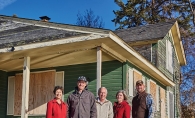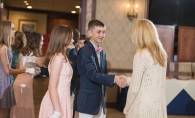
With an enrollment of over 3,000, Minnetonka High School is undoubtedly big, which can easily feel overwhelming for incoming freshman. Getting involved with an activity or club, however, is the best medicine—and the best way to make new friends. Whether it’s a sports team, music ensemble, volunteer organization or something else entirely, participating in an extracurricular activity can transform a high schooler’s experience. Minnetonka High makes it easy to get connected, thanks to its hundreds of school-sponsored teams, clubs and groups—and the Skippers Booster Club helps them run.
Founded in 1973, the Skippers Booster Club is a nonprofit organization that raises money for the many different clubs and activities at MHS. Since that time, it has given hundreds of thousands of dollars to a wide range of school-sponsored groups, and at 44 years old, it’s the longest-running booster club in the district.
Stacy Joslin and Traci Peterson, both parents of MHS students, serve on the board as the Booster Club’s co-presidents. The club, they say, has simple roots. “The history is that it was a bunch of parents [who] wanted to get together and form co-curricular enrichment clubs,” says Joslin. And that’s exactly what it is today—only now significantly larger.
Made up entirely of MHS parents—around 70 this year—the Skippers Booster Club maintains an active presence at MHS. Through funding sports teams, enrichment clubs, volunteer groups and the like, it encourages students to be active in their school community. The boosters’ support ensures that students have an enriching high school experience and are engaged both within and outside of the classroom.
“It takes a village, and they are a big part of that village,” says Ted Schultz, student activities director at MHS. He oversees the booster club and says that its impact on MHS is immense. “By raising the funds, it takes a lot of the stress off of the kids, and they have some [resources] when they need to do what it is they’re trying to do.”
The club has a simple concept but a big effect. It is open to any interested parent or community member; all that’s required is a donation of at least $25, which goes directly to fund MHS activities. The board holds monthly meetings throughout the school year, with the biggest one each June, when members review funding applications from MHS groups and vote on which to grant money to. Any team, club or activity that is officially recognized by MHS is eligible—all they have to do is apply, and once the money is granted, they are able to spend it on whatever they wish.
During the 2016-17 school year, the booster club gave nearly $75,000 to 50 different MHS groups, and their impressive budget helps make such generosity possible. Although donations and fundraising make up a portion of the budget, it’s not the largest source of funds. Last year, 3 percent came from donations, 4 percent from fundraising, and the remaining 93 percent from the Skippers Booster Store, unique to both the club and MHS. Located in the MHS Student Commons, the Booster Store sells MHS-branded apparel and accessories—much like a college a bookstore, only in a high school. “We’ve had some other schools come into our store, and they’ve always been like, ‘Oh my gosh—this is amazing,’” says Joslin. “You feel like you’re walking into a Gap or something—it’s really nice.”
Above all, Booster Club members want to emphasize that all student groups at MHS can request funding from them. “We are trying to get it out that we support everybody, not just the football team,” says Peterson. Although they are certainly happy to help out MHS athletics, Joslin and Peterson say that supporting some of the lesser-known groups is especially rewarding. Last year, the 30 groups that received Booster Club funding were a diverse bunch that included the Earth club, the Jewish student union, the Spanish club and the mountain bike team.
“It’s nice for some of the smaller clubs that maybe don’t have as much of an ability to raise funds,” Joslin says. “It’s really nice that we are also able to give them financial support.”
As long as Minnetonka High School’s doors are open, the Skippers Booster Club plans to be around. It plays a critical role in making a student’s four years at MHS memorable and prepares them for life after graduation. “The purpose of extracurriculars and co-curriculars is to give these kids a significant experience—belonging, lifelong skills, all of those things,” Schultz says. “The booster club’s support helps make that happen.”
A Sampling of Clubs
Backpack Tutoring
With nearly 425 students participating, Backpack Tutoring is the largest extracurricular activity at MHS. Students work one-on-one with first- through fifth-graders at Jefferson Community School or Folwell Performing Arts, both in Minneapolis.
“We’ve always [gone to] schools that are really struggling, and we tutor kids who are in what they call the ‘red zone,’ meaning they’re behind in reading and/or math,” says Diana Davis, who, with her husband, is one of the program’s volunteer advisors. “Our tutors not only serve as mentors to the kids they’re paired with but also [provide] academic help.”
Backpack Tutoring is a big commitment—students spend one afternoon each week from mid-fall to spring break tutoring in Minneapolis. But it’s a commitment that they’re happy to make and an experience they find rewarding.
“I can’t count how many of our tutors come back and tell us how these kids have impacted their lives,” says Davis. Through data tracking, they’ve found that the program has resulted in dramatic improvements in reading and math skills for Jefferson and Folwell students. “It’s such a win-win for both sides—the high schoolers and the kids who are getting tutored.”
Funding from the Booster Club helps cover Backpack Tutoring’s sole expense: busing to and from the schools each day.
Robotics Team
Robotics is a varsity sport through the Minnesota State High School League, and the MHS team, Chicken Bot Pie, is among the best in the state. Each year, the team designs, builds and programs its own robot to compete in the FIRST (For the Inspiration and Recognition of Science and Technology) Robotics Competition.
Every January, FIRST announces the year’s challenge. Teams then have six weeks to build a robot to meet the challenge. Past challenges have included building a robot capable of picking up gear, flinging Frisbees and scaling a pyramid.
Advisor Katie Hessen says that the robotics competition is unique in that it emphasizes the value of teamwork both within and across teams. “They are always on an alliance,” she says. MHS students pool their resources and knowledge to teach each other new skills, and if a part happens to break or they run into a roadblock, other local teams are there to help troubleshoot.
Robot parts are far from cheap. Between all the different pieces, including sensors, cameras and motors, the final product can easily cost several thousand dollars. Funding from the Booster Club helps the team buy new motors and gear so they can ensure their robot is in top shape for competition.
Astronomy Club
At their weekly meetings, the MHS astronomy club might be busy with any number of things. They could be discussing the week’s latest news in astronomy, learning about a new concept or planning an activity to share their love of space and science with others.
However, science teacher Russ Durkee, one of the advisors of the club, says that “star parties” are the biggest part of what they do. Astronomy Club members meet after dark to stargaze and study the night sky. Oftentimes, they’ll invite third- and fourth-graders in Minnetonka’s Navigator program to join. The high schoolers put together science- and astronomy-related activities and demonstrations for the younger students. Of course, they also have telescopes and binoculars to observe the moon, stars and planets up close, which they thank the Booster Club for.
“There are just not very many sources of funding for clubs like ours, so we are very grateful for the support,” Durkee says.
Minnetonka Mentors
Although Minnetonka Mentors is a newer program, it has already had a profound impact on its participants. MHS students on the autism spectrum are paired with adult mentors, also on the spectrum, many MHS alums themselves. Through monthly meetings and activities, students form tight-knit relationships with their mentors, who share their own experiences, struggles and coping strategies for navigating both adolescence and autism.
Support from the Booster Club has allowed Minnetonka Mentors to purchase copies of Been There. Done That. Try This! An Aspie’s Guide to Life on Earth for each of the students. Advisor Kelly Kautz says that the book is a tremendous resource for students, and individual copies of the book would not be possible without the support from the Booster Club.









